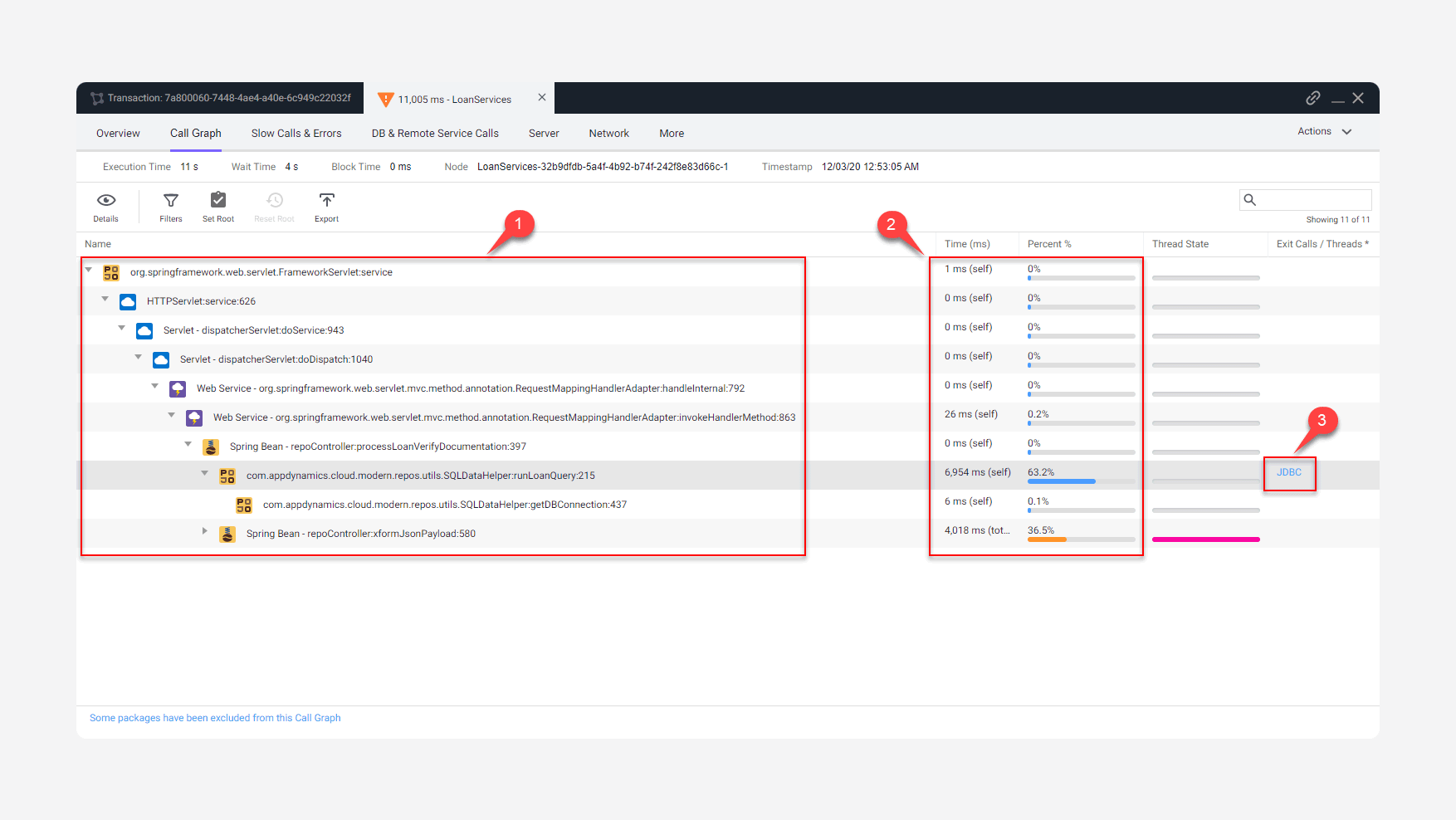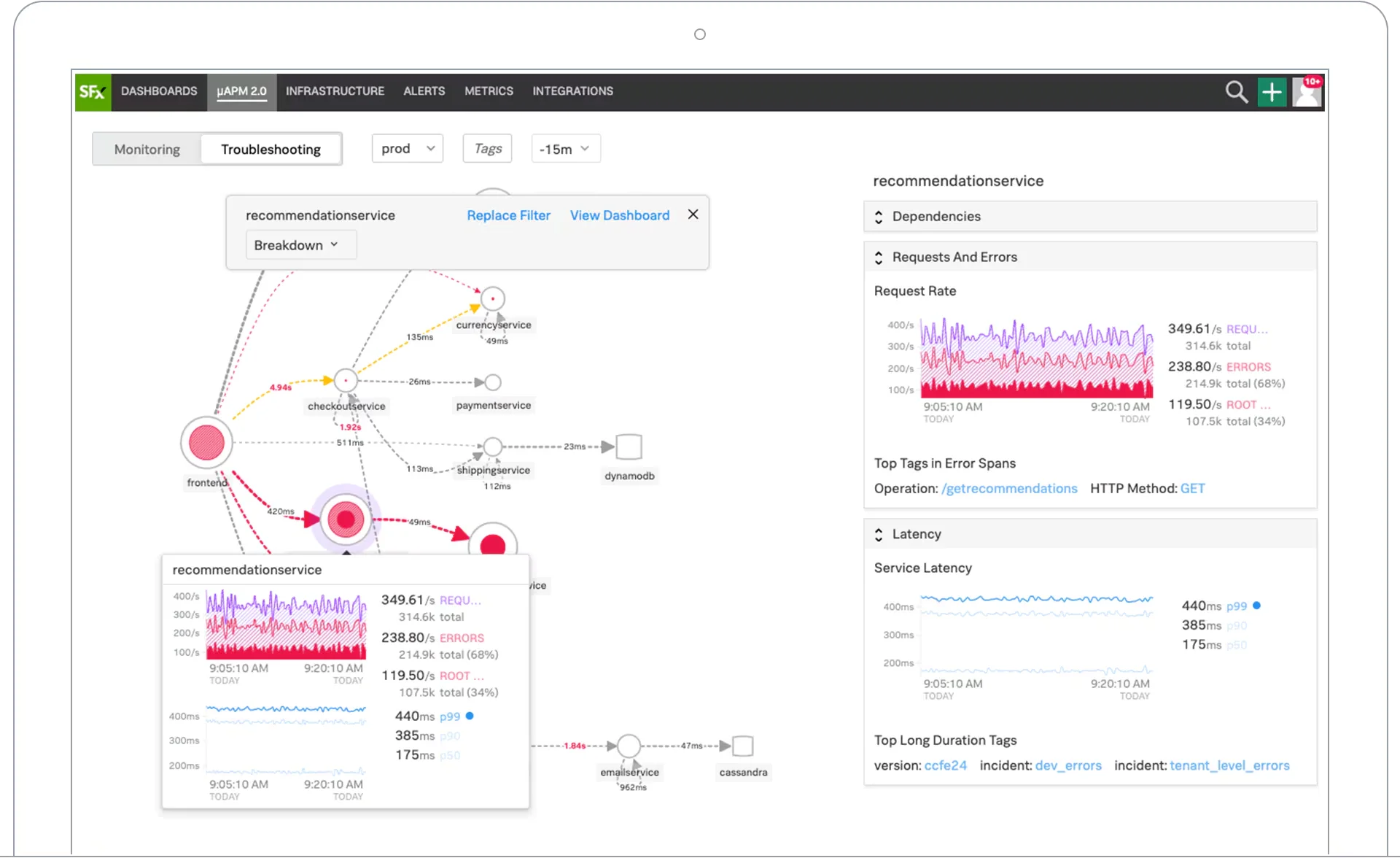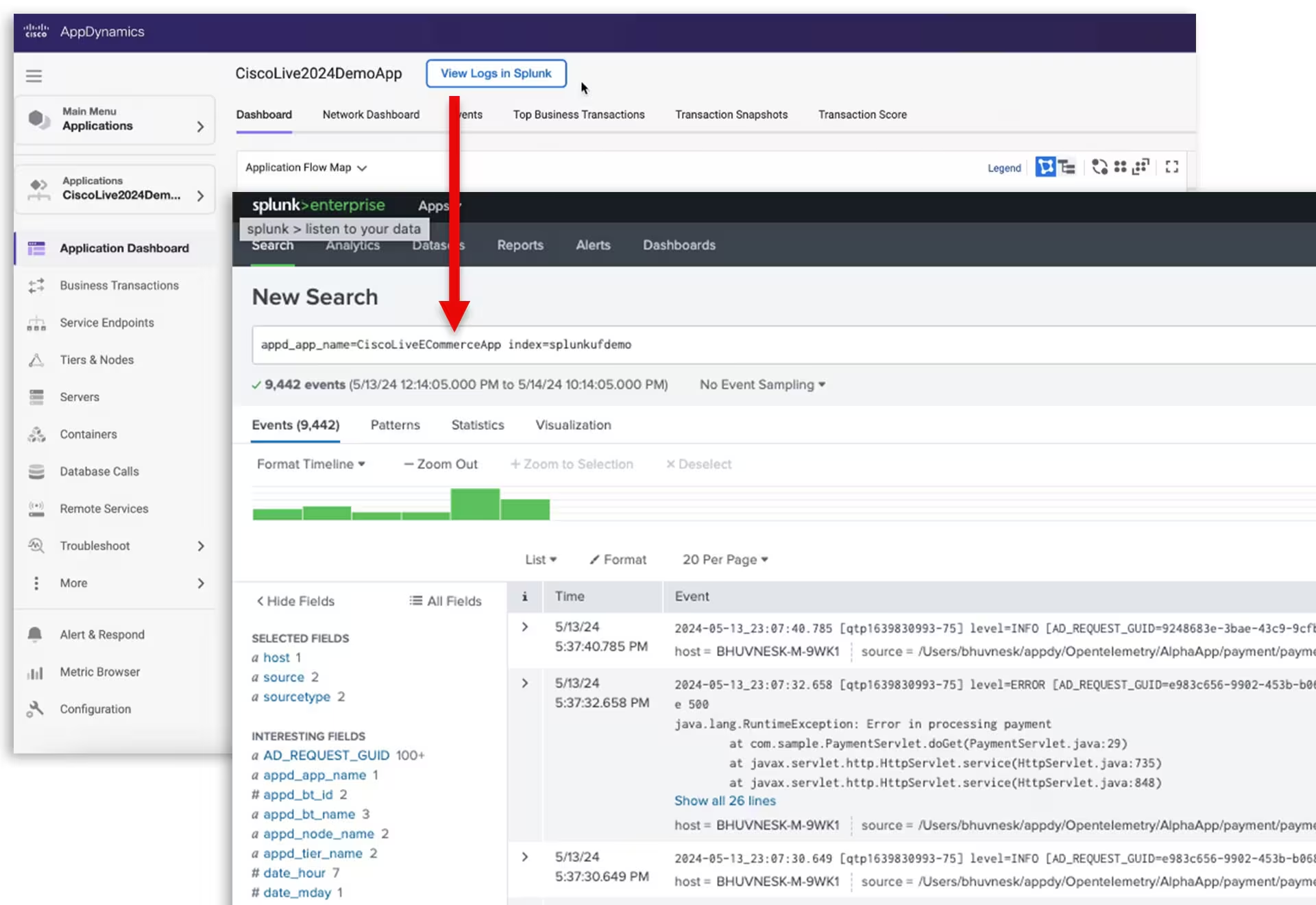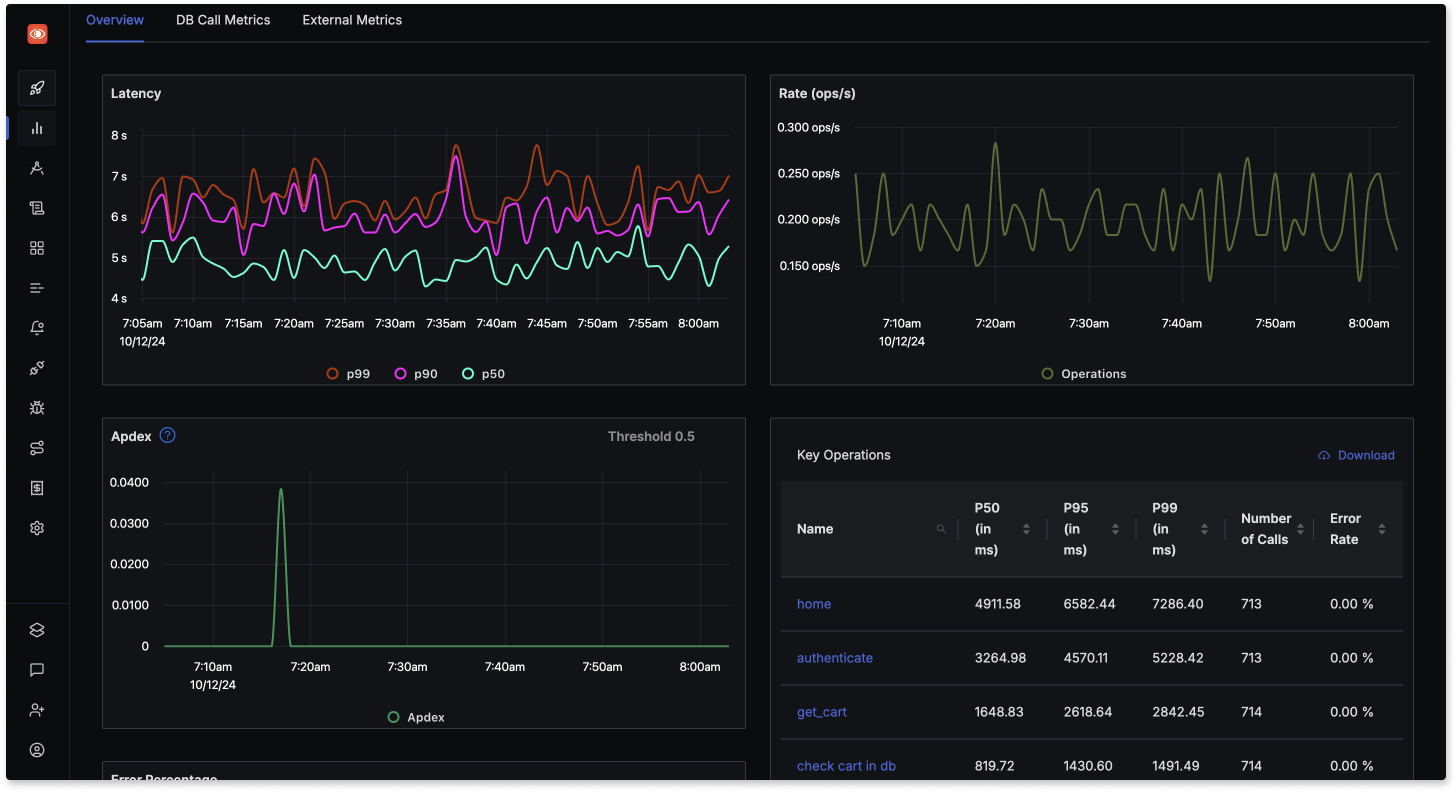AppDynamics, now part of Splunk's Observability portfolio (following Cisco's acquisition), and Splunk's broader platform together form a unified observability solution. While these tools now live under the same corporate umbrella, they still retain distinct strengths and focuses that make comparing them valuable for organizations making technology decisions.
This article compares the two with a special focus on APM, log management, security analytics, integrations, pricing, and usability, while explaining how they now complement each other in Cisco's unified observability strategy.
Overview of AppDynamics and Splunk
To make the comparison meaningful, it's essential to understand what AppDynamics and Splunk offer and how they differ fundamentally in focus and capabilities, even as they become increasingly integrated.
AppDynamics
AppDynamics (acquired by Cisco, and now part of Splunk's Observability portfolio) is a full-stack APM and observability tool focused on ensuring optimal application performance. It's built for quick root-cause analysis - when performance degrades, it shows where and why, down to the line of code, database query, or external API.
Core Features:
- Auto-discovers application dependencies and monitors applications in real-time
- Tracks business transactions, mapping the journey of a single request across services
- Provides code-level diagnostics for deep insights into bottlenecks
- Aligns IT metrics with business outcomes – showing how performance issues impact revenue or user experience
AppDynamics specializes in real-time application performance monitoring, offering deep visibility into how individual components of your system interact, from cloud-native microservices to legacy on-prem applications.

Splunk
Splunk started as a log and machine-data analytics platform and has since evolved into a comprehensive observability suite. It operates like a forensic expert, sifting through mountains of log data to uncover patterns, anomalies, and insights—whether it's for IT operations or security incidents.
Core Features:
- Specializes in ingesting and indexing massive volumes of machine data (logs, metrics, and events)
- Features powerful querying and visualization tools through its Splunk Processing Language (SPL)
- Provides enterprise-grade security monitoring with its Splunk Enterprise Security (SIEM) module
- Unifies performance monitoring with log-based troubleshooting in one ecosystem
Splunk's strength in analyzing machine data and its newer APM tools means it can unify performance monitoring with log-based troubleshooting and security monitoring in one ecosystem.

How AppDynamics Fits into the Splunk Ecosystem
Cisco has been actively unifying AppDynamics with Splunk to deliver a seamless full-stack observability experience. Some key integrations include:
- Unified Access via SSO: Single sign-on enables users to move securely between the two platforms, streamlining workflows for daily troubleshooting.
- In-Context Deep Linking: Through Log Observer Connect integration, AppDynamics issues can be linked directly to relevant logs in Splunk, preserving context and speeding up root-cause analysis.
- Centralized Log Collection: AppDynamics can forward application logs into Splunk's logging platform, centralizing log data for analysis alongside metrics and traces.

- "Better Together" Full-Stack Observability: AppDynamics tells you what, when, and where a problem is happening in the application, while Splunk shows why through supporting log data.
The combined AppDynamics and Splunk offering delivers end-to-end visibility from user experience to application code to infrastructure and logs, with streamlined workflows that help teams resolve issues faster.
Even within the same corporate family, the tools maintain distinct areas of excellence. AppDynamics excels at application performance and root-cause analysis, while Splunk remains the leader in log aggregation and enterprise security.
Application Performance Monitoring (APM) - AppDynamics vs Splunk
Both AppDynamics and Splunk provide robust APM capabilities, but they approach it from different perspectives and with different strengths.
AppDynamics APM
AppDynamics offers one of the most comprehensive APM experiences in the industry, as this is its core functionality.
- Key Features:
- Automatically discovers and maps application components and their relationships
- Tracks business transactions end-to-end across distributed services
- Provides code-level diagnostics to pinpoint exact bottlenecks
- Uses machine learning for dynamic baselining and anomaly detection
- Offers intuitive visual flow maps for easy navigation of complex app topologies
AppDynamics excels in automated transaction tracing with minimal configuration. Once agents are installed, it provides deep visibility into application performance with intuitive visual maps, making it easier to identify and resolve issues quickly.
Splunk APM
Splunk's APM capabilities (part of Splunk Observability Cloud) provide comprehensive monitoring across distributed systems with a focus on full-fidelity tracing.
- Key Features:
- Ingests 100% of trace data with no sampling for complete visibility
- Natively supports OpenTelemetry for instrumenting services
- Offers predictive analytics to forecast potential performance issues
- Provides customizable dashboards for real-time monitoring
- Seamlessly integrates with Splunk's broader ecosystem for unified observability
Splunk APM shines in high-granularity tracing for complex, cloud-native microservice ecosystems. Its ability to ingest all trace data without sampling ensures no anomaly is missed, while its predictive capabilities help teams stay ahead of potential issues.
Log Management - AppDynamics vs Splunk
Logs are an area where Splunk has a long-established reputation, while AppDynamics approaches logs more as a supplementary feature:
Splunk for Log Management
Splunk is often synonymous with log management. It can ingest logs from virtually any source (servers, applications, network devices, etc.), index them, and make them searchable with its powerful Splunk Search Processing Language (SPL).
- Key Features:
- Real-time log tailing and analysis
- Advanced querying and filtering capabilities
- Visualization of log data trends
- Alerting based on log patterns (e.g., error rates)
- Transaction logging (grouping related log events)
- Extensive ecosystem of apps for specific log types
Splunk offers industry-leading log analysis capabilities, allowing you to identify patterns, anomalies, and root causes from your log data with ease. It's a cornerstone tool for many DevOps and IT teams in troubleshooting incidents because you can quickly sift through huge volumes of log data to pinpoint issues.
AppDynamics for Log Management
AppDynamics is not primarily a log management tool, but it recognizes the value of logs in performance troubleshooting.
- Key Features:
- Analytics add-on (Business iQ) for log ingestion
- Correlation of log events with application performance metrics
- Log collection via agent extensions or integrations
- Native integration with Splunk for enhanced capabilities
With the integration between AppDynamics and Splunk, teams now get the best of both worlds. AppDynamics focuses on APM data (metrics, traces, events) while leveraging Splunk for deep log analysis. The native integration allows you to send Splunk alerts into AppDynamics and query Splunk logs from the AppDynamics UI when investigating performance issues.
With their integration, Splunk's industry-leading log capabilities complement AppDynamics' application performance focus, creating a more comprehensive solution than either tool alone.
Security Analytics - AppDynamics vs Splunk
When it comes to security monitoring and analytics, the two platforms have different strengths:
Splunk for Security Analytics
Splunk is widely used in the security domain through Splunk Enterprise Security (SIEM) and Splunk User Behavior Analytics (UBA).
- Key Features:
- Ingests security-relevant data (system logs, authentication events, network traffic logs)
- Equipped with correlation rules and threat detection content out of the box
- Uses AI-driven analytics to detect anomalies that could indicate cyber threats
- Detects patterns of failed logins, unusual process activity, or suspicious network traffic
- Provides adaptive response framework for automated actions (alerts, system quarantine)
- Serves as a full-fledged security analytics solution alongside IT monitoring
Splunk provides a comprehensive security analytics platform that makes it a go-to choice for organizations wanting to combine operational and security data in one place. Security teams (SecOps) often leverage Splunk as their central dashboard for incident detection and investigation.
AppDynamics for Security Analytics
AppDynamics is primarily oriented toward performance, but since becoming part of Cisco, it has gained security capabilities at the application level.
- Key Features:
- Works with Cisco Secure Application to perform application security monitoring
- Detects vulnerabilities like insecure configurations or libraries
- Can block certain attacks in real-time within applications
- Provides Runtime Application Self-Protection (RASP) capabilities
- Helps reduce risk within the application layer without impacting performance
- Focuses on the security posture of monitored applications
Within Cisco's unified observability approach, AppDynamics contributes to security by safeguarding application runtime and providing security event data, which can then be integrated with Splunk's broader security analytics. This gives organizations both application-level security monitoring and enterprise-wide security intelligence.
Integration and Extensibility
Integrations and extensibility are critical for modern observability tools, allowing them to adapt to diverse ecosystems and unique business needs. Here's how AppDynamics and Splunk compare:
AppDynamics Ecosystem
- Cloud & Infrastructure Integrations:
- Provides extensions for AWS, Azure, and Google Cloud that pull in CloudWatch or Azure Monitor metrics
- Correlates cloud service metrics (AWS Lambda, DynamoDB, Azure App Services) with application performance
- Monitors containerized environments through specialized agents for Docker and Kubernetes
- Offers comprehensive visibility across hybrid infrastructure environments
- Extensions & APIs:
- Features 130+ extensions for databases, message queues, and specific frameworks
- Provides robust REST APIs for data extraction, automation, and custom integrations
- Enables integration with CI/CD pipelines (Jenkins, Azure DevOps) for deployment health monitoring
- Connects with incident management tools like PagerDuty and Slack for alert notifications
Splunk's Integration Capabilities
- Cloud & Infrastructure Monitoring:
- Offers official add-ons for AWS, Azure, and Google Cloud that ingest logs, events, and metrics
- Provides Infrastructure Monitoring module specifically designed for cloud environments
- Deploys OpenTelemetry Collector or native agents to gather data from Kubernetes pods and orchestrators
- Enables comprehensive monitoring beyond application code into cloud service performance
- Extensive Marketplace:
- Features SplunkBase with hundreds of pre-built apps and add-ons for diverse use cases
- Covers DevOps tools (Jenkins, Docker), configuration management, and specialized monitoring needs
- Includes Splunk On-Call (formerly VictorOps) for integrated incident response
- Integrates with ticketing systems like ServiceNow for streamlined workflow management
Community & Ecosystem Comparison
- AppDynamics:
- Maintains AppDynamics Exchange marketplace for extensions
- Offers a focused community centered on performance monitoring use cases
- Provides extensions primarily targeting APM-related technologies and integrations
- Splunk:
- Boasts a larger community and marketplace with broader use cases
- Features community-contributed apps covering security, IoT, analytics, and specialized data sources
- Provides integration options for virtually any data source through community-built add-ons
- Hosts regular community events including the annual Splunk .conf conference
Cisco Full-Stack Observability Integration
- Combined Future:
- With Cisco's acquisition of both AppDynamics and Splunk, integration between the platforms is increasing
- Cisco's Full-Stack Observability (FSO) vision combines AppDynamics' APM strengths with Splunk's log analytics
- Features like Log Observer Connect allow users to jump from AppDynamics traces directly to related Splunk logs
- Organizations can now leverage both tools as complementary solutions under Cisco's unified approach
Both platforms offer robust integration capabilities, with AppDynamics providing deep APM-focused integrations and Splunk offering an exceptionally broad ecosystem covering diverse IT and business needs. Cisco's acquisition has created new opportunities for these tools to work together more seamlessly.
User Interface and Ease of Use
The user interface (UI) and ease of use can significantly impact the adoption and effectiveness of an observability tool. Here's how AppDynamics and Splunk compare:
AppDynamics UI & Experience
- Flow Map Visualization:
- Auto-detects interactions between components as soon as agents are installed
- Creates intuitive diagrams showing services calling other services, databases, and external APIs
- Helps new users quickly grasp system topology and health at a glance
- Navigation & Dashboards:
- Enables straightforward drilling down by clicking on nodes or transactions to see deeper metrics
- Provides customizable dashboards with sensible defaults showing key application KPIs
- Displays critical metrics like response time, error rate, throughput, and health rule violations
- Learning Curve:
- Features a relatively gentle learning curve for basic use cases
- Allows DevOps engineers to identify performance issues soon after installation
- Offers powerful comparison features (before/after deployments, business impact) without requiring scripting
Splunk UI & Experience
- Dual Interface Approach:
- Traditional log search interface is text-centric with SPL query bar and configurable results
- Modern Observability Cloud provides more intuitive, point-and-click interfaces for APM and monitoring
- Presents service maps showing calls between services similar to AppDynamics' flow map
- Search & Analysis Capabilities:
- Powers advanced data analysis through the Search Processing Language (SPL)
- Enables users to calculate custom SLOs, correlate unusual events, and perform statistical analysis
- Allows investigation of performance spikes by clicking chart points to see related traces or logs
- Customization & Learning:
- Supports highly customizable dashboards with charts, tables, and text for different team needs
- Requires more learning to fully exploit its flexibility and advanced capabilities
- Provides extensive documentation and active community support for users
Comparative Usability
- AppDynamics Advantage:
- Offers more polished, graphical representation of performance data
- Enables quicker diagnosis of issues without writing queries
- Provides purpose-built UI for APM with less configuration time
- Splunk Advantage:
- Delivers exceptional flexibility for slicing and dicing data during deep investigations
- Excels in custom analytics and unified dashboards across diverse data types
- Balances power-user capabilities with increasingly intuitive interfaces in newer offerings
- Integration Benefits:
- Cisco's unified observability approach now allows teams to benefit from both interfaces
- Deep linking between platforms lets users maintain context when moving between tools
- Access to the right interface for the right task improves overall user experience
AppDynamics generally provides a more streamlined experience for pure application monitoring use cases, while Splunk offers greater analytical depth for users willing to invest in learning its query language and customization options. The integration between them now gives users the best of both worlds.
Performance and Scalability
Performance and scalability are critical factors when deploying observability solutions at scale. Here's how AppDynamics and Splunk compare:
AppDynamics Performance & Scalability
- System Resource Requirements:
- Introduces 2-5% CPU overhead on monitored systems
- Requires 16GB RAM for Controller in small deployments (up to 50 agents)
- Demands low-latency disk I/O for optimal Controller performance
- Consumes variable network bandwidth based on agent count and metrics
- Scalability Characteristics:
- Supports up to 1,000,000 metrics per minute across ~1,500 agents in medium deployments
- Requires 8 CPU cores and 128GB RAM for medium-sized implementations
- Needs 5TB of SSD-based storage for medium deployments
- Benefits from high-availability configurations in enterprise environments
Splunk Performance & Scalability
- System Resource Requirements:
- Recommends 16 CPU cores and 64GB RAM for indexers in medium deployments
- Requires high-performance storage (SSDs preferred) for indexing operations
- Demands high network throughput for data ingestion and cluster replication
- Performs optimally with dedicated resources rather than virtualized environments
- Scalability Characteristics:
- Handles up to 200GB/day per indexer for certain data sources like CloudTrail
- Requires 16 CPU cores and 64GB RAM for indexer nodes
- Benefits from SSD storage for search heads with high query loads
- Utilizes indexer clusters with replication for enhanced availability
Comparative Performance
- AppDynamics Advantage:
- Offers lower overhead on monitored systems
- Provides real-time application performance insights with minimal impact
- Delivers optimized performance for APM-specific workloads
- Splunk Advantage:
- Excels at handling massive data volumes across diverse sources
- Scales horizontally through distributed architecture
- Supports extensive data retention and historical analysis
- Unified Architecture Benefits:
- Organizations can optimize resource allocation based on workload types
- Integration enables efficient data sharing without duplicate storage
- Cisco's unified approach helps minimize overall resource requirements
AppDynamics is optimized for real-time application monitoring with minimal system impact, while Splunk is engineered for large-scale data ingestion and analytics across diverse IT environments. Together, they offer complementary approaches to enterprise-scale observability.
Which Approach Should You Choose?
With AppDynamics now part of Splunk's portfolio under Cisco, the question shifts from "which one" to "how to best leverage both." However, understanding their distinct strengths helps optimize your observability strategy.
Best when your primary goal is deep application performance monitoring with out-of-the-box code-level insights. It's ideal for teams that want a guided APM solution with automatic visualization of complex distributed applications. AppDynamics excels when you need to quickly identify slow transactions, get method-level diagnostics, and connect application performance to business metrics.
Optimal when log management is critical to your operations or when you need a unified platform for logs, metrics, traces, and security events. It's perfect for SREs who frequently move between metrics and logs during investigations and for organizations seeking to integrate observability with security practices.
Leveraging the Unified Approach
With Cisco's acquisition bringing these tools together, many organizations are now implementing a unified strategy:
Integrated Workflow: Use AppDynamics for application monitoring and Splunk for log aggregation and security, with deep linking between them for seamless troubleshooting.
Specialized Teams: Allow development teams to focus on AppDynamics for application insights while operations and security teams leverage Splunk's broader analytics capabilities.
Tiered Deployment: Deploy AppDynamics for your most critical business applications while using Splunk to monitor your broader IT infrastructure and security posture.
Evaluate based on your primary challenges and team structure. Leverage AppDynamics' strength in application performance and user experience monitoring alongside Splunk's powerful log analytics and security capabilities. The integration between these platforms now allows you to build a comprehensive observability strategy that draws on the best of both tools while maintaining workflow continuity.
Splunk Observability vs. Other APM Solutions
With AppDynamics now part of Splunk's Observability suite, Splunk is positioning itself against other full-stack monitoring leaders like Datadog, New Relic, and Dynatrace. Here's how they compare:
Splunk Observability (with AppDynamics): The combined platform now offers unified metrics, traces, logs, and digital experience monitoring. Its greatest strength is in log analytics, where it can ingest and query massive volumes of data with flexibility. The addition of AppDynamics strengthens Splunk's APM capabilities significantly.
Datadog: A popular cloud-native observability platform with APM, logs, metrics, and more in a unified SaaS offering. Datadog is known for easy onboarding and rich cloud service integrations, but its pricing model can lead to surprises for large-scale deployments.
New Relic: A veteran in the APM space that has evolved into a full observability platform. New Relic offers robust APM capabilities and a relatively transparent pricing model. Its log analytics, while improved, is not as flexible or scalable as Splunk's.
Dynatrace: Known for its AI-driven approach and automated discovery of dependencies. Dynatrace provides precise root-cause analysis but is a relatively heavy, proprietary solution that can be expensive in large environments.
Each platform offers a broad set of features that can monitor modern applications, but factors like ecosystem integration, cost model, and specific feature strengths will influence which is best for your organization.
SigNoz: An Open-Source Alternative
SigNoz is a modern, open-source observability platform that provides Application Performance Monitoring (APM), metrics, logs, and distributed tracing in a unified solution. Built on OpenTelemetry, it offers comprehensive insights into application performance without the licensing fees associated with proprietary tools.

Key Features Comparison:
- SigNoz vs. AppDynamics and Splunk: SigNoz covers similar observability pillars (metrics, traces, logs) but as a completely open-source tool. Its OpenTelemetry-native approach means you avoid vendor lock-in, as your instrumentation is standardized.
Benefits of Open-Source APM:
- No Vendor Lock-In: With SigNoz, organizations have full control over their observability data, reducing dependency on any single vendor.
- Customizable Data Retention Policies: Users can define how long to retain data, optimizing storage costs and compliance requirements.
- Lower Total Cost of Ownership (TCO): Self-hosting SigNoz can lead to significant cost savings compared to subscription-based proprietary tools.
Getting Started with SigNoz:
To explore SigNoz's capabilities, you can set up the platform by following the official SigNoz Documentation. The documentation provides step-by-step guides on installation, instrumentation, and dashboard customization.
SigNoz Cloud is the easiest way to run SigNoz. Sign up for a free account and get 30 days of unlimited access to all features.
You can also install and self-host SigNoz yourself since it is open-source. With 24,000+ GitHub stars, open-source SigNoz is loved by developers. Find the instructions to self-host SigNoz.
Key Takeaways
- AppDynamics is now part of Splunk's Observability portfolio under Cisco, creating a unified full-stack observability solution.
- AppDynamics excels in real-time, application-centric APM with robust root-cause analysis capabilities.
- Splunk remains a leader in log analytics, security monitoring, and IT operations.
- The integration between these tools provides seamless workflows from application performance to log analysis.
- SigNoz offers an open-source alternative with potentially lower costs and without vendor lock-in.
FAQs
How has the relationship between AppDynamics and Splunk changed?
AppDynamics was acquired by Cisco, which later acquired Splunk, bringing both tools under the same corporate umbrella. They're now integrated as complementary components of Cisco's unified observability strategy.
Can AppDynamics and Splunk be used together effectively?
Yes, and this is now officially supported and encouraged. Integration features like deep linking and shared SSO make it easier than ever to use AppDynamics for deep application performance insights alongside Splunk for broader IT analytics and security monitoring.
Which tool is better for cloud-native applications?
Both offer excellent cloud capabilities. AppDynamics is strong for microservices transaction tracing, while Splunk excels at large-scale distributed logs and metrics. Their combined solution provides comprehensive cloud-native monitoring.
What are the main alternatives to the Splunk/AppDynamics combination?
Commercial alternatives include Datadog, New Relic, and Dynatrace. Open-source options include SigNoz, Prometheus + Grafana, and the OpenTelemetry ecosystem.
How does the Cisco acquisition affect pricing and licensing?
While specific pricing strategies continue to evolve, Cisco is working to create more integrated licensing options that allow customers to leverage both AppDynamics and Splunk capabilities efficiently. Contact your account representative for the latest pricing information.
